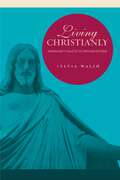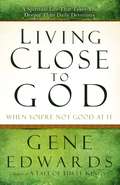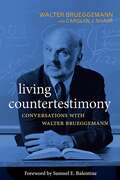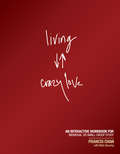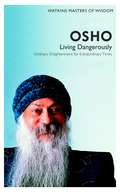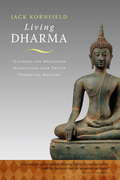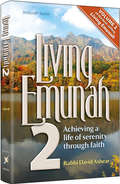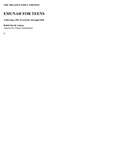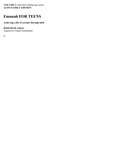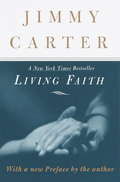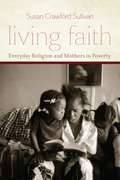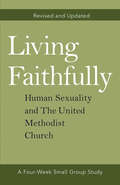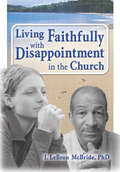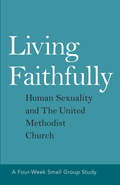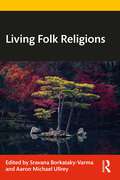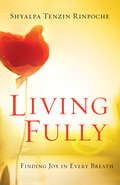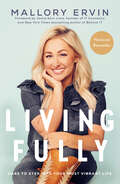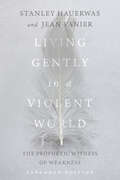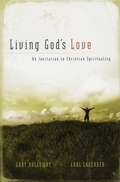- Table View
- List View
Living Christianly: Kierkegaard's Dialectic of Christian Existence
by Sylvia WalshThe pseudonymous works Kierkegaard wrote during the period 1843–46 have been responsible for establishing his reputation as an important philosophical thinker, but for Kierkegaard himself, they were merely preparatory for what he saw as the primary task of his authorship: to elucidate the meaning of what it is to live as a Christian and thus to show his readers how they could become truly Christian. The more overtly religious and specifically Christian works Kierkegaard produced in the period 1847–51 were devoted to this task. In this book Sylvia Walsh focuses on the writings of this later period and locates the key to Kierkegaard’s understanding of Christianity in the “inverse dialectic” that is involved in “living Christianly.” In the book’s four main chapters, Walsh examines in detail how this inverse dialectic operates in the complementary relationship of the negative qualifications of Christian existence—sin, the possibility of offense, self-denial, and suffering—to the positive qualifications—faith, forgiveness, new life/love/hope, and joy and consolation. It was Kierkegaard’s aim, she argues, “to bring the negative qualifications, which he believed had been virtually eliminated in Christendom, once again into view, to provide them with conceptual clarity, and to show their essential relation to, and necessity in, securing a correct understanding and expression of the positive qualifications of Christian existence.”
Living Close to God (When You're Not Good at It): A Spiritual Life That Takes You Deeper Than Daily Devotions
by Gene EdwardsHave you tried harder to have a consistent time with the Lord--but failed?Does your mind wander during prayer, and do you run out of things to say?Do you question why it is so hard to fellowship with the Lord?Stop feeling like a failure at daily devotionsGene Edwards faced these same questions and struggles. And he found a better way to walk with the Lord than merely trying harder to pray and read the Bible.and start walking every day with the Lord who loves you.In Living Close to God (When You're Not Good at It) you will discover that loving God means much more than doing your best to serve Him. You will find ways to start your day with Christ, beginning with your first conscious thought in the morning. You will learn how to fellowship with Him during even the most demanding days. And when you go to the Scriptures, you will talk with Him in a two-way conversation--just as His first followers did.Includes a small-group discussion guide and a guidefor your own relationship with God. From the Trade Paperback edition.
Living Countertestimony
by Walter Brueggemann Carolyn J. SharpThis volume invites readers to get up close and personal with one of the most respected and beloved writers of the last four decades. Carolyn J. Sharp has transcribed numerous table conversations between Walter Brueggemann and his colleagues and former students, in addition to several of his addresses and sermons from both academic and congregational settings. The result is the essential Brueggemann: readers will learn about his views on scholarship, faith, and the church; get insights into his "contagious charisma," grace, and charity; and appreciate the candid reflections on the fears, uncertainties, and difficulties he faced over the course of his career. Anyone interested in Brueggemann's work and thoughts will be gifted with thought-provoking, inspirational reading from within these pages.
Living Courageously: You Can Face Anything, Just Do It Afraid
by Joyce MeyerFear commonly affects our ability to live fully, holding us back from what enriches our lives and the lives of others. But our quality of life will improve when we learn how to be courageous in the face of fear.In LIVING COURAGEOUSLY, Joyce Meyer explains how, as Christians, we can overcome the paralyzing power of fear by calling upon the Lord. "Fear not" is written throughout the Bible. God knows His children will be confronted with fear, but He can help us resist it. It is your inherited right as a child of God to live life to the fullest and to enjoy it. Joyce will encourage you to be expectant as you learn to conquer fear, become all God wants you to be, and do all He wants you to do. With a blend of personal insight and inspiring Scripture, this book will help you employ the power of God to overcome fear and achieve your best.
Living Courageously: You Can Face Anything, Just Do It Afraid
by Joyce MeyerEveryone who has ever lived has known the torment of fear. Fear will try to push you back and is always ready to attack you through your thoughts. But you can live free from it!God's promise is that you will be able to overcome this powerful emotion. In this book, Joyce Meyer shows that even though fear will surely challenge you, the Holy Spirit can still help you walk in faith. Find out:- How to keep fear from controlling your life- How to move forward in spite of your fears- How God stays faithful regardless of what you're feeling- The one basic fear underneath all fears.You can act on God's Word and defeat this enemy. Now is the time to seize victory, by stepping out to do it afraid!
Living Crazy Love
by Francis Chan Mark BeuvingFrom New York Times Best-Selling author Francis Chan comes fresh insight into the love of God. Chan's new thoughts and reflections on God's love in Living Crazy Love allows the book to stand alone or be used as a companion to Crazy Love. This ten-week in-depth study of God's character helps readers embrace God's intense, relentless love and watch that love transform every aspect of their being. Designed for individuals or small groups, this study includes weekend retreat options and tips for small group leaders. However readers choose to use this book, Francis Chan's thought-provoking teaching will help them pursue God as they never have before, digging deep into their thoughts and beliefs about the love of God and how that love should impact their lives.After all, the spiritual journey is about so much more than what Christians have made it to be--and once they truly encounter God's love, they will never be the same.
Living Dangerously: Ordinary Enlightenment for Extraordinary Times
by OshoOsho is one of the best-known spiritual teachers of our time. The Sunday Times named him one of the '1,000 makers of the twentieth century'; the novelist Tom Robbins has called him 'the most dangerous man since Jesus Christ'. Nearly two decades after his death in 1990, the influence of his teachings continues to grow, reaching seekers around the world. This inspiring compendium of spiritual wisdom and insight offers a way for everyone to access the enlightening message of the Buddha as Osho offers his unique take on his teachings, with a wisdom and wit that make it a wonderful read. When you engage with Osho's writing, you feel as if he is speaking to you. His conversational style is fluid and engaging, and while his acute perception often comes as a delight and a surprise, his shrewd insights will stay with you always. Whether he is discussing a complex philosophy, or the teachings of a great mystic, Osho always approaches the subject with his own distinctively irreverent, thought-provoking and inspiring perspectives. Covering subjects including Belief, Responsibility, Relationships, Doing Good and the Power of Consciousness, this is a book that offers real insight into leading a more spiritual life now.
Living Dharma: Teachings and Meditation Instructions from Twelve Theravada Masters
by Ram Dass Jack Kornfield Chogyam TrungpaIn this book, Jack Kornfield presents the heart of Buddhist practice as taught by twelve highly respected masters from Southeast Asia. These renowned teachers offer a rich variety of meditation techniques: the practices include traditional instructions for dissolving the solid sense of self, for awakening insight, for realizing Nirvana, and for cultivating compassion for all beings. Jack Kornfield's first three chapters give an overview of Buddhist philosophy and, specifically, the meditation practices of Burma, Thailand, and Laos. The teachings in this volume are from Achaan Chaa, Mahasi Sayadaw, Sunlun Sayadaw, Achaan Buddhadasa, Achaan Naeb, Achaan Maha Boowa, Tuangpulu Sayadaw, Mohnyin Sayadaw, Mogok Sayadaw, U Ba Khin, Achaan Dhammadaro, and Achaan Jumnien.
Living Emunah
by Rabbi AshearLiving Emunah Volume 4 of the best-selling Living Emunah 4 Achieving a life of serenity through faith
Living Emunah 2 (ArtScroll Series)
by Rabbi David AshearLiving Emunah transformed the lives of tens of thousands of people, taking them on a breathtaking journey towards tranquility and happiness - through faith. <p><p> Now, Living Emunah 2 brings us even further on the road to serenity. <p> It's a priceless gift, emunah. It gives us the tools to endure tragedy and disappointment. It helps us to surmount the insurmountable, to create goals and achieve them. And, yes, it enables us to experience true happiness, the joy that comes from realizing that Hashem knows what is happening in our lives - and will only do what is best for us. <p> With more than thirty-five thousand copies in printLiving Emunah's, short, accessible and wise daily readings have become a vital part of people's lives. In Living Emunah 2 we discover still more ways to make emunah a part of our daily life. We see how emunah can change our response to something as small as a traffic jam on a busy day, or as great as a major life challenge. <p> We all sometimes have questions. Why weren't my heartfelt prayers answered? If Hashem loves us, why is there so much suffering? If I have emunah, can I still cry in pain? In stories, parables and, of course, in the words of our sages and Torah leaders, Living Emunah 2 helps us find the answers. <p> In our ultra-hyped world, we are offered so many pathways to happiness that lead to dead ends. But with emunah in our lives, we can move forward on the road to joy, knowing that Hashem is with us every step of the way.
Living Emunah for Teens: Achieving a Life of Serenity Through Faith
by David Ashear Chana NestlebaumHey Teens! Now You Can Also Join the "Emunah Revolution!" Imagine starting every day with a smile Imagine dealing with problems in school and at home, instead of worrying about them. Imagine being the kind of positive person that everyone likes to be with. Imagine being happy. Really happy. It can happen. The secret is emunah. <p><p>The Living Emunah series has sold more than 100,000 copies to people who want to strengthen their emunah—the belief that Hashem is involved in all aspects of our lives, that He loves us and knows what's best for us. <p><p>Teens today have questions and problems and concerns all their own—and now they have a book that's written just for them—Living Emunah for Teens, adapted from Rabbi David Ashear's bestselling Living Emunah. In realistic scenarios and true stories, teens will learn how emunah can change and enrich their lives. How emunah can free them from anger or jealousy. How they can find the good in everything and everyone—including themselves. Every segment also includes a "Make it Real" guide, to help bring the lessons of emunah into their lives. Living Emunah for Teens. Because emunah is for everyone!
Living Emunah for Teens: Achieving a Life of Serenity Through Faith
by Rabbi David AshearIn Living Emunah for Teens, thousands of teenagers discovered how emunah—the unshakeable trust that Hashem loves you, and only does what’s good for you—is the secret to living a life without fear, doubts, and despair. More: It’s the secret to a life of happiness and confidence. <p><p>With its Torah insights, true-life stories, and advice for practical applications of emunah in a teen’s life, Living Emunah for Teens 2 takes teenagers even further on this joyous journey to serenity. With close to 200,000 (!) copies in print, the Living Emunah series has helped many tens thousands of people find the happiness that comes from trusting Hashem. Now teenagers, too, can bring emunah into their lives.
Living Emunah: Achieving A Life Of Serenity Through Faith
by David AshearThrough the classic lens of Torah thought as well as true-life stories discover what emunah is and what it isn't, how to strengthen your faith, and how to bring it into your homes, offices, and lives. Each selection is short, readable, and infinitely wise. -- adapted from publisher's web page.
Living Emunah: Achieving a Life of Serenity Through Faith (Living Emunah #3)
by David AshearEmunah. Believe it. Live it. Feel it! Strengthening emunah, our faith in Hashem, in His Providence, in His infinite goodness, enriches and even transforms our lives. Emunah replaces anxiety with optimism, and grants us serenity in place of fear. With nearly 100,000 copies in print, the Living Emunah series has become the premier resource for those - and there are so, so many of us - who have embarked on the wonderful journey to emunah. And what a journey it is! Filled with healing, comfort, and the knowledge that Hashem is with us everywhere - in the traffic jam, the hospital unit, the boardroom and the bank. Emunah accompanies us in the hard times, a faithful friend who reminds us that we are never alone, never abandoned, a soothing voice that tells us not to lose hope. Living Emunah 3 continues to guide us on this marvelous and rewarding path. With stories and with the wisdom of the Sages, each brief and absorbing segment melds the classic Torah understanding of faith with our day-to-day encounters. It reinforces and deepens our understanding of HashemÂ’s love for us in all times and situations. When we transform our relationship to Hashem through emunah, we transform our relationships to others as well. Jealousy, anger, and frustration have no place in a world of emunah. As our love for Hashem grows stronger so, too, does our love for others (yes, including our love for ourselves!). Not everyone, says Rabbi David Ashear, author of the Living Emunah books, can be a gadol ha’dor, a great Torah sage. But anyone can become a “gadol b’emunah,” a giant in faith and trust. Like the earlier books in the series, Living Emunah 3 gives us the tools, the inspiration, and the understanding we need for the journey to emunah. Have a wonderful trip!
Living Emunah: Achieving a Life of Serenity through Faith (Living Emunah #5)
by Rabbi David AshearLiving Emunah 5
Living Faith
by Jimmy CarterMake it easy on yourself, read Living Faith in Large Print* All Random House Large Print Editions are published in a 16-point typeFor almost three decades, President Carter has regularly spent part of each Sunday reading from scripture and sharing his personal faith with neighbors, friends, and visitors at his Baptist church in Plains, Georgia. In Living Faith, he draws on this experience, exploring the values closest to his heart and the personal beliefs that have nurtured and sustained him.For President Carter, faith finds its deepest expression in a life of compassion, reconciliation, and service to others. Living Faith is filled with stories of people whose lives have touched his--some from the world stage, more from modest walks of life. We see how President Carter learned about other faiths from Prime Minister Menachim Begin and President Anwar Sadat; learned a lesson in forgiveness from a clash with commentator George Will; how he was inspired by the simple theology of preacher Ely Cruz, "Love God and the person in front of you"; and how the cheerful strength of family friend Annie Mae Rhodes taught him the meaning of "patient faith."Rooted in scripture and infused with a vision of how a dynamic faith can enrich our public and private lives, this is the most personal book yet by one of our most admired Americans--a warmly inspirational volume to give and to share.From the Trade Paperback edition.
Living Faith: Everyday Religion and Mothers in Poverty
by Sullivan Susan CrawfordScholars have made urban mothers living in poverty a focus of their research for decades. These women’s lives can be difficult as they go about searching for housing and decent jobs and struggling to care for their children while surviving on welfare or working at low-wage service jobs and sometimes facing physical or mental health problems. But until now little attention has been paid to an important force in these women’s lives: religion. Based on in-depth interviews with women and pastors, Susan Crawford Sullivan presents poor mothers’ often overlooked views. Recruited from a variety of social service programs, most of the women do not attend religious services, due to logistical challenges or because they feel stigmatized and unwanted at church. Yet, she discovers, religious faith often plays a strong role in their lives as they contend with and try to make sense of the challenges they face. Supportive religious congregations prove important for women who are involved, she finds, but understanding everyday religion entails exploring beyond formal religious organizations. Offering a sophisticated analysis of how faith both motivates and at times constrains poor mothers’ actions, Living Faith reveals the ways it serves as a lens through which many view and interpret their worlds.
Living Faithfully Revised and Updated: Human Sexuality and The United Methodist Church
by Alex Joyner Rebekah Jordon Dave Barnhart Jill M. JohnsonThere is deep disagreement about what The United Methodist Church should teach about homosexuality, same gender marriage, and the ordination of LGBTQ persons. In 2019, a special session of General Conference was held to consider these issues and how they will be addressed by The United Methodist Church in the future. Yet many have felt that the outcome of the special session did not lead to resolution, but to increased tension and deepening division.Living Faithfully is designed to help you understand the shape of this debate and what it means for the present and the future. Each chapter includes background on the Bible, Christian theology, history, stories from diverse viewpoints, and United Methodist structure and practice to guide reflection and conversation. You’ll also find definitions of key terms and information about upcoming events.The four chapters are:1. Is the Practice of Homosexuality Incompatible with Christian Teaching?2. Is Same-gender Marriage Compatible with Christian Teaching?3. Is Ordaining Practicing Homosexuals Compatible with Christian Teaching?4. Where Are We Now?This revised four-week study contains an updated fourth chapter that describes the outcome of the 2019 General Conference and the ongoing debates and responses to it. It will help you understand and grapple with various views about the ministry and teaching of The United Methodist Church around issues of human sexuality. It will lead you to have honest, well-informed, and grace-filled conversations with others about these matters and the calls for change. And it will help you discern, in prayer and conversation, how you can respond faithfully in love of God and neighbor.A Leader Guide is included with lesson plans to help facilitate a four-session small group study.From the Faultlines collection, resources intended to inform conversations around human sexuality and the church.
Living Faithfully with Disappointment in the Church
by J. LeBron McBrideA practical approach to address spiritually crippling disappointment with the church! Feeling disappointment with your church can be spiritually devastating. Living Faithfully with Disappointment in the Church gives you a theological and family therapy approach to disillusionment in the church that is practical and realistic. The author, an ordained minister and a licensed family therapist, discusses with sensitivity and hope the problems and the ways to resolve issues of spiritual disappointment.Living Faithfully with Disappointment in the Church uses a theological basis to lay a foundation of understanding, and then provides real strategies from a family therapy perspective to deal with personal disappointments in the church. The book sensitively discusses real problems using real examples of how church dynamics can unwittingly cause spiritual disillusionment within even the most faithful, even in diligent attempts to serve God. Honest, reverent, and written from the perspective that each of us needs the church to cultivate our faith, this book provides non-simplistic yet hopeful answers to the most difficult of problems. Find comfort in these pages. Living Faithfully with Disappointment in the Church discusses: idealism about the church how churches function according to the dynamics of family systems how a controlling family affects church dynamics people who become codependent to the church adjustment to belief structures within the church addictive processes in organizations the psychological danger zone of failed beliefs how to recognize when to stay and when to move on to another church considerations for someone in a denominational crisis the uses of spirituality and religion in psychologically healthy waysa theoretical model that gives priority to building a relational church Living Faithfully with Disappointment in the Church is for ministers, chaplains, seminary students, pastoral counselors, Sunday school teachers, or anyone that is facing a spiritual crisis in their church. Each chapter includes questions for reflection and discussion.
Living Faithfully: Human Sexuality and The United Methodist Church
by Alex Joyner Jill M Johnson Rebekah Jordon Dave BarnhartThere is deep disagreement about what The United Methodist Church should teach about homosexuality, same gender marriage, and the ordination of LGBTQ persons. In 2019, a special session of General Conference will be held to consider these issues and how they will be addressed by The United Methodist Church in the future. Living Faithfully is designed to help you understand the shape of this debate and what it means for the present and the future. Each chapter includes background on the Bible, Christian theology, history, stories from diverse viewpoints, and United Methodist structure and practice to guide reflection and conversation. You’ll also find definitions of key terms and information about upcoming events. The four chapters are: 1. Is the Practice of Homosexuality Incompatible with Christian Teaching? 2. Is Same-gender Marriage Compatible with Christian Teaching? 3. Is Ordaining Practicing Homosexuals Compatible with Christian Teaching? 4. Where Are We Now? This four-week study will help you understand and grapple with various views about the ministry and teaching of The United Methodist Church around issues of human sexuality. It will lead you to have honest, well-informed, and grace-filled conversations with others about these matters and the calls for change. And it will help you discern, in prayer and conversation, how you can respond faithfully in love of God and neighbor. A Leader Guide is included with lesson plans to help facilitate a four-session small group study. From the Faultlines collection, resources intended to inform conversations around human sexuality and the church.
Living Folk Religions
by Sravana Borkataky-Varma Aaron Michael UllreyLiving Folk Religions presents cutting-edge contributions from a range of disciplines to examine religious folkways across cultures. This collection embraces the non-elite and non-sanctioned, the oral, fluid, accessible, evolving religions of people (volk) on the ground. Split into five sections, this book covers: What Is Folk Religion? Spirit Beings and Deities Performance and Ritual Praxis Possession and Exorcism Health, Healing, and Lifestyle Topics include demons and ambivalent gods, tree and nature spirits, revolutionary renunciates, oral lore, possession and exorcism, divination, midwestern American spiritualism, festivals, queer sexuality among ritual specialists, the dead returned, vernacular religions, diaspora adaptations, esoteric influences underlying public cultures, unidentified flying objects (UFOs), music and sound experiences, death rituals, and body and wellness cultures. Living Folk Religions is a must-read for those studying Comparative Religions, World Religions, and Religious Studies, and it will also interest specialists and general readers, particularly enthusiastic readers of Anthropology, Folklore and Folk Studies, Global Studies, and Sociology.
Living Fully
by Shyalpa Tenzin RinpocheWe all aspire to live fully and freely in the moment. In Living Fully, Shyalpa Tenzin Rinpoche reveals timeless wisdom that can help us fulfill this deepest aspiration. Each succinct teaching is a luminous jewel, an invaluable guide to actualizing our innate potential and breathing with joy and ease. Today, with so many struggling with financial, relationship, and career challenges, Living Fully: Finding Joy in Every Breath is a timely prescription. Rinpoche offers the tools we need to experience genuine inner freedom, uncorrupted by endless craving for something better. Topics include beginning with a pure motivation, the preciousness of breath, healing oneself and others, the essence of meditation, and spontaneous fulfillment. Shyalpa Tenzin Rinpoche has written the book that our troubled age has been yearning for. It is a treasure trove of heartfelt advice on how to seize the moment and live with kindness and understanding. Rinpoche's teachings gently beckon us home to the purity and simplicity of our true nature. At peace with ourselves and at ease with the world, we can discover what it means to live our lives fully.
Living Fully: Dare to Step into Your Most Vibrant Life
by Mallory ErvinAn irresistible guide to living without holding back, from the vibrant lifestyle entrepreneur and host of the Living Fully podcastOne of Katie Couric Media&’s Best New Self Help Books to Read in the New Year • &“If you&’re ready to up-level your life and create long-lasting change, then this book is for you! Mallory&’s resilient path will inspire you to step into your power.&”—Gabrielle Bernstein, #1 New York Times bestselling author of The Universe Has Your Back Mallory Ervin is known for exuding energy, joy, and laughter. But despite her public accomplishments, Mallory is no stranger to battling unhealthy attachments to performance and success. Now, in her unforgettable debut book, Mallory invites readers to see how her surprising journey—from achievement and accolades to devastating, never-before-shared lows—guided her and led her to a deeply fulfilling life. In Living Fully, Mallory shares her personal story of overcoming the unhealthy and damaging patterns in her life and shows readers how to trade this for something completely new and more rewarding. What she discovered was there had always been a different life available to her, one that she had not yet seen. Now she encourages readers to resist a &“just fine&” existence and to step into a life they never dared to imagine before. Through inspiring stories and practical advice Mallory encourages readers to: • stop returning to a &“just getting by&” mentality• shift perspective so blessings don&’t become burdens• remember that life&’s curveballs don&’t have to knock you off your feet• identify your passions and get back to your truest self• slow down and enjoy the extraordinary in the everyday moments• quiet the voice of fear• get clear on the life you want &“I wrote this to be your wake-up call, the thing that turns the lights on in your life and propels you to make real change, once and for all,&” Mallory says. &“I want you to wake up and stay awake.&” For anyone hungry for a richer life, or tired of coasting through life in a &“cruise control&” mindset, Living Fully is the ultimate invitation to embrace abundance and joy—and not look back!
Living Gently in a Violent World: The Prophetic Witness of Weakness (Resources For Reconciliation)
by Stanley Hauerwas Jean VanierHow are Christians to live in a violent and wounded world? Rather than contending for privilege by wielding power and authority, we can witness prophetically from a position of weakness. The church has much to learn from an often-overlooked community—those with disabilities. <p><p> In this fascinating book, theologian Stanley Hauerwas collaborates with Jean Vanier, founder of the worldwide L'Arche communities. For many years, Hauerwas has reflected on the lives of people with disability, the political significance of community, and how the experience of disability addresses the weaknesses and failures of liberal society. And L'Arche provides a unique model of inclusive community that is underpinned by a deep spirituality and theology. Together, Vanier and Hauerwas carefully explore the contours of a countercultural community that embodies a different way of being and witnesses to a new order—one marked by radical forms of gentleness, peacemaking, and faithfulness. <p> The authors' explorations shed light on what it means to be human and how we are to live. The robust voice of Hauerwas and the gentle words of Vanier offer a synergy of ideas that, if listened to carefully, will lead the church to a fresh practicing of peace, love and friendship. This invigorating conversation is for everyday Christians who desire to live faithfully in a world that is violent and broken. <p> This expanded edition now includes a study guide for individual reflection or group discussion.
Living God's Love: An Invitation to Chrisitan Spirituality
by Gary HollowayDo you want a deeper relationship with God? A closer walk with Jesus? A sense of the Holy Spirit's constant presence? Is this the deepest desire of your heart, but you don't know where to begin?This book is for you. It offers no shortcuts or sure-fire techniques for a deeper spirituality. But it serves as a simple and easy-to-follow signpost marking the path of daily relationship with God.God invites you into relationship with him, just as you are. Even if you're not sure about God, even if you have no religious background, even if you've been a churchgoer all your life, God invites you to share his very life. It is a life richer than you can imagine.
